US Pharm. 2015;40(6):HS35-HS40.
According to the National Cholesterol Education Program (NCEP), the American Diabetes Association (ADA), and the CDC, the importance of understanding lipid and glucose levels is paramount in reducing healthcare costs and deaths from preventable conditions.1-3
Dyslipidemia
Dyslipidemia is defined as an elevation of plasma cholesterol or triglycerides (TG), or both, or a low high-density lipoprotein (HDL) level that contributes to the development of atherosclerosis. Primary causes of dyslipidemia can include gene mutations that result either in overproduction or defective clearance of TG and low-density lipoprotein (LDL) cholesterol or in underproduction or excessive clearance of HDL. Secondary causes of dyslipidemia include sedentary lifestyle with excessive dietary intake of saturated fat and cholesterol.4
Cholesterol is a lipid found in all animal tissues, blood, bile, and animal fats that is essential for cell membrane formation and function, hormone synthesis, and fat-soluble vitamin production. Cholesterol travels through the bloodstream in lipoproteins.5 LDLs deliver cholesterol to cells, where it is used in membranes or for the synthesis of steroid hormones.6 An elevated LDL level leads to a buildup of cholesterol in the arteries.5 Conversely, HDL gathers excess cholesterol from the cells and brings it back to the liver.6 Elevated cholesterol in the blood can combine with other substances, resulting in plaque formation. TG are esters derived from glycerol and three-fatty acids generally stored in the fat cells. Hormones release TG for energy between meals. TG may raise the risk of heart disease and are considered a sign of metabolic syndrome; thus, lipid monitoring is important because uncontrolled dyslipidemia can lead to the development of coronary heart disease.7
Dyslipidemia is diagnosed using a serum lipid profile test.1 This test measures total cholesterol, HDL cholesterol, TG, and calculated LDL cholesterol. The National Cholesterol Education Program Adult Treatment Panel III (NCEP ATP III) guidelines are found in TABLE 1.1
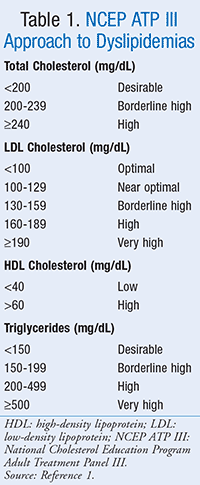
Diabetes Mellitus
Diabetes mellitus is a chronic disease that is characterized by a dysfunction of the body’s use of insulin and glucagon. Glucagon is secreted in response to low glucose concentration, resulting in glycogenolysis. Insulin is secreted in response to food intake, causing cells to take up glucose from the blood and convert it to glycogen for storage.8 A dysfunction in glucagon or insulin can lead to hyperglycemia. Diabetes may eventually damage the eyes, kidneys, nerves, heart, and blood vessels. There are many tests used
to diagnose diabetes mellitus. Some of these tests include random blood glucose and fasting plasma glucose tests.9 Blood glucose standards are found in TABLE 2.10
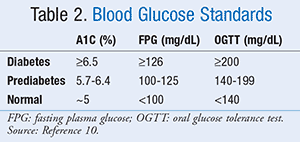
Epidemiology
According to the CDC, 71 million American adults (33.5%) have dyslipidemia. Only 1 out of 3 people with high cholesterol has the condition under control. The average total cholesterol of adult Americans is 200 mg/dL.11 The CDC estimates that 29.1 million Americans (9.3%) have diabetes, with 21 million diagnosed and 8.1 million (27.8%) undiagnosed.2
LipidPlus
Cleared by the FDA in 2013, the LipidPlus Lipid Profile and Glucose Measuring System (FIGURE 1) from Jant Pharmacal Corporation is a combination meter that provides an avenue for healthcare professionals to monitor lipids and glucose without the use of an outside laboratory or venipuncture.12 The LipidPlus monitor can be utilized in multiple settings to help reduce or even eliminate the amount of time a patient and healthcare team have to wait for lipid panel screening.
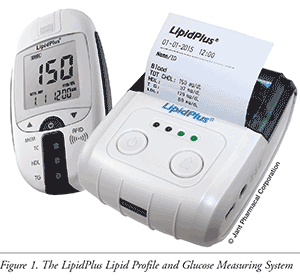
LipidPlus employs two different forms of test methods, lipid profile and blood glucose.13 The lipid profile test result is based on a reading of reflection density. When blood is applied, the color changes in the test area through an enzyme reaction. The meter records this change in color and converts the measurement to a numerical reading that is displayed for the user.
The LipidPlus requires test strips, a capillary rod, and a disposable, single-use lancing device, which is designed to allow individuals, regardless of status and specialized training, to obtain accurate lipid panel and glucose readings.13 Patient instructions for blood glucose and lipid screening are outlined in TABLEs 3 and 4. Additionally, this device has a memory that stores up to 200 results and automatically replaces the oldest results with newer ones once the memory is full. Test results can also be transmitted to a personal computer or printed on a thermal printer.
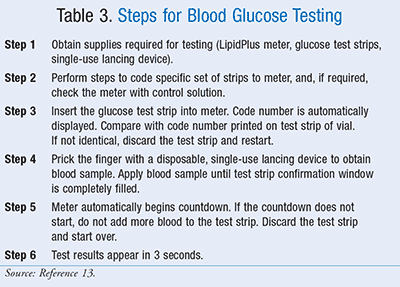
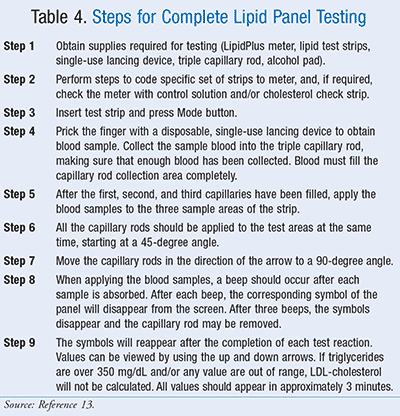
Efficacy
The accuracy of the LipidPlus device was confirmed by comparing 1,200 capillary whole blood specimens at three different centers to the Roche Cobas chemistry system.13 Total cholesterol, HDL cholesterol, and TG were determined to have a range of R-squared values from 0.9933 to 0.9983 when using Cobas as a reference line for the data set. Precision was also confirmed by measuring three different levels in venous whole blood samples over 20 days with a standard deviation <6 mg/dL and a coefficient of variation (CV) <2.7%.13
The accuracy of the glucose portion of the LipidPlus system was confirmed by comparing the glucose levels of 160 patients at three different clinical centers to the Hitachi Glucose Autometer 747.13 Known glucose concentrations <75 mg/dL were 100% accurate within ±5 mg/dL, ±10 mg/dL, and ±15 mg/dL in the results of 27 patients. Glucose concentrations ≥75 mg/dL were 100% accurate within ±15%-20%, 98% accurate within ±10%, and 75% accurate within ±5% in 133 patients. Precision of the glucose portion was evaluated using venous whole blood samples in five different levels with a CV of <3.2%.13
Conclusion
LipidPlus provides a convenient, accurate, and cost-effective way to test for total cholesterol, HDL, LDL, TG, and blood glucose levels. This device is designed with a large screen to display accurate, easy-to-read results. LipidPlus is a small, portable, handheld analyzer that is battery-operated and can transmit results to a computer or thermal printer. This combination system is an ideal solution for healthcare providers to monitor at-risk patients. For more information about LipidPlus, contact Jant Pharmacal at 800-676-5565 or info@lipidplus.com.
REFERENCES
1. Third Report of the National Cholesterol Education Program (NCEP) Expert Panel on Detection, Evaluation, and Treatment of High Blood Cholesterol in Adults (Adult Treatment Panel III) final report. Circulation. 2002;106:3143-3421.
2. CDC. 2014 National Diabetes Statistics Report. October 14, 2014. www.cdc.gov/diabetes/data/statistics/2014statisticsreport.html. Accessed July 20, 2014.
3. CDC, Division for Heart Disease and Stroke Prevention. Cholesterol fact sheet. www.cdc.gov/dhdsp/data_statistics/fact_sheets/fs_cholesterol.htm. Accessed July 20, 2014.
4. Goldberg A. Dyslipidemia. Merck Manual Professional Version. www.merckmanuals.com/professional/endocrine_and_metabolic_disorders/lipid_disorders/dyslipidemia.html. Accessed July 6, 2014.
5. National Heart, Lung, and Blood Institute. Explore high blood cholesterol. https://www.nhlbi.nih.gov/health/health-topics/topics/hbc/. Accessed July 6, 2014.
6. University of Washington courses web server. Cholesterol, lipoproteins and the liver. http://courses.washington.edu/conj/bess/cholesterol/liver.html. Accessed July 10, 2014.
7. Mayo Clinic. High cholesterol. www.mayoclinic.org/diseases-conditions/high-blood-cholesterol/in-depth/triglycerides/art-20048186. Accessed June 10, 2014.
8. Diabetes.co.uk. Glucagon. www.diabetes.co.uk/body/glucagon.html. Accessed July 15, 2014.
9. Mayo Clinic. Diabetes. www.mayoclinic.org/diseases-conditions/diabetes/basics/tests-diagnosis/con-20033091. Accessed June 20, 2014.
10. National Diabetes Information Clearinghouse (NDIC). Diagnosis of diabetes and prediabetes. http://diabetes.niddk.nih.gov/dm/pubs/diagnosis. Accessed July 27, 2014.
11. CDC. High cholesterol facts. www.cdc.gov/cholesterol/facts.htm. Accessed July 18, 2014.
12. LipidPlus. Jant Pharmacal Corporation. www.lipidplus.com. Accessed May 18, 2015.
13. Professional LipidPlus Lipid Profile and Glucose Measuring System: Operation Manual. Encino, CA: Jant Pharmacal Corporation; 2013.
To comment on this article, contact rdavidson@uspharmacist.com.





